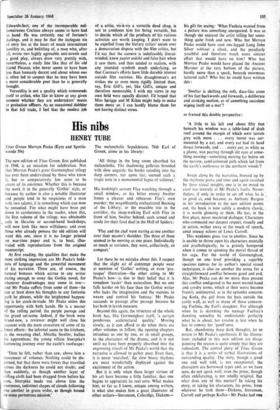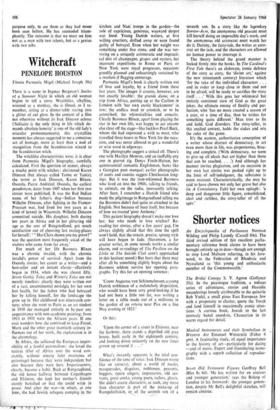His nibs
HENRY TUBE
The new edition of Titus Groan, first published in 1946, is an occasion for celebration. Not that Mervyn Peake's great Gormenghast trilogy has ever been undervalued by those who know it, but so comparatively few seem to be aware of its existence. Whether this is because the work is in the generally 'Gothic' style, or because its author is also a notable illustrator and people tend to be suspicious of a man with two talents, it is something which can now be remedied. For what might have been put down to carelessness in the reader, when this, the first volume of the trilogy, was obtainable only in libiaries or second-hand bookshops, will now look like mere wilfulness; and even those who already possess the old edition will want this one, since it is no longer printed on war-time paper and is, to boot, illus- trated with reproductions from the original manuscript.
At first reading, the qualities that make the most striking impression are Mr Peake's bold- ness of language and the powerful movement of his narrative. These are, of course, the natural bonuses which accrue to any writer daring enough to essay the Gothic novel, for whatever disadvantages may come in tow— and Mr Peake suffers from some of them—he can at least dress his thoughts in any fantastic garb he pleases, while the heightened happen- ing is his stock-in-trade. Mr Peake seizes this opportunity with both hands. He is a master of the rolling period, the purple passage and the grand set-scene. Indeed, if the book were brand-new, a reviewer might well close his account with the mere evocation of some of its finest effects: the infernal scene in the kitchens, as the sweating chef, Abiatha Swelter, bullies his apprentices; the young villain Steerpike's harrowing journey over the castle's roofscape: 'Then he felt, rather than saw, above him a movement of volumes. Nothing could be dis- cerned, but that there were forces that travelled across the darkness he could not doubt; and then suddenly, as though another layer of stifling cloth had been dragged from before his eyes, Steerpike made out above him the enormous, indistinct shapes of clouds following one another in grave order, as though bound on some portentous mission.'
The melancholic Sepulchrave, 76th Earl of Groan, alone in his library: 'All things in the long room absorbed his melancholia. The shadowing galleries brooded with slow anguish; the books receding into the deep corners, tier upon tier, seemed each a tragic note in a monumental fugue of volumes.'
His lordship's servant Flay watching through a small window, as his bitter enemy Swelter hones a cleaver and rehearses Flay's own murder; the magnificently orchestrated Burning of the Libtary; or the macabre trio in the corridor, the sleep-walking Earl with Flay in front of him, Swelter behind, each armed and ready for their fatal duel in the Hall of Spiders : 'Flay and the chef were staring at one another over their master's shoulder. The three of them seemed to be moving as one piece. Individually so much at variance, they were, collectively, so compact.'
Let there be no mistake about this. I suspect that the slight air of contempt people wear at mention of 'Gothic' writing, or even 'gro- tesque' illustration—the other string to Mr Peake's bow—is due to their belief that it is somehow 'easier' than naturalism. But no one falls harder on his face than the Gothic writer who lacks the imagination and the stamina to weave and control his fantasy. Mr Peake succeeds in passage after passage because he has both in lavish measure.
Beyond this again, the structure of the whole book has, like Gormenghast itself, 'a certain ponderous architectural quality.' Moving slowly, as it can afford to do when there are other volumes to follow, the opening chapters intr.oduce us one by one, or in small groups, to the characters of the drama, and it is not until we have been properly absorbed into the engrossing rituals of Mr Peake's world that the narrative is allowed to gather pace. Even then, it is never 'snatched,' the slow heavy rhythms are most wonderfully deployed against the excitement of the action.
But it is only when these larger virtues of his art have become a little familiar, that one begins to appreciate its real core. What makes him, so far as I know, unique among writers, is what also makes him a great illustrator of other writers—Stevenson, Coleridge, Dickens- his gift for seeing : 'What Fuchsia wanted from a picture was something unexpected. It was as though she enjoyed the artist telling her some- thing quite fresh and new. Who but Mervyn Peake would have seen one-legged Long John Silver without a cloak, and the peculiarly youthful and therefore much more sinister effect that would have on him? Who but Mervyn Peake would have placed the Ancient Mariner at the very bottom of the picture, hardly more than a speck, beneath enormous tattered sails? Who but he could have written this:
'Swelter is shifting the soft, dace-like areas of his feet backwards and forwards, a deliberate and stroking motion, as of something succulent wiping itself on a mat'?
or framed this double perspective:
'A little to his left and about fifty feet beneath his window was a table-land of drab roof around the margin of which were turrets grey with moss . . . every turret was sur- mounted by a cat, and every cat had its head thrust forwards, and ... every cat, as white as a plume, was peering through slit eyes at some- thing moving—something moving far below on the narrow, sand-coloured path which led from the castle's outhouses to the northern woods'?
Swept along by the narrative, buoyed up by the rhythmic prose and time and again ravished by these visual insights, one is in no mood to cavil too severely at Mr Peake's faults. Never- theless, if only in order to set off what he is so good at, and because, as Anthony Burgess in his introduction to the new edition points out, the book is now safely a modern classic, it is worth glancing at them. He has, in the first place, never mastered dialogue. Characters who command our deepest respect, visually and in action, wither away at the touch of speech, amid uneasy echoes of Lewis Carroll.
This weakness gives rise to another. Since he is unable to throw open his characters mentally and psychologically, he is gravely hampered when it comes to spinning the moral thread of his saga. For the world of Gormenghast, though on one level providing a superbly spacious canvas for its author's special visual techniques, is also on another the arena for a straightforward conflict between good and evil. Alas, Mr Peake can do no more than present this conflict undigested in the most second-hand and tawdry terms, which at their worst become frankly sentimental, as in the episodes concern- ing Keda, the girl from the huts outside the castle wall, as well as many of those concern- ing Fuchsia, the Earl's daughter. For although when he is sketching the teenage Fuchsia's dawning sexuality he understands perfectly what he is about, her creator is lost when he has to convey her 'good'-ness.
But, abandoning these dark thoughts, let us return to Mr Peake's apotheosis. If the illustra- tions included in this new edition are disap- pointing the reason is quite simply that they are redundant. The central glory of Titus Groan is that it is a series of verbal illustrations of outstanding quality. The story, though a good one and well told, is not exceptional; the characters are borrowed types and, as we have
seen, do not speak well; even the prose, though often exhilarating, is not wholly original. But
what does any of this matter? In taking his story, in taking his characters, his prose, from wherever he took them—Dickens, Stevenson, Carroll and perhaps Kafka—Mr Peake had one
purpose only, to see them as they had never been seen before. He has succeeded trium- phantly. The outcome is that we must see him not as a man with two talents, but as a genius with two nibs.



































 Previous page
Previous page